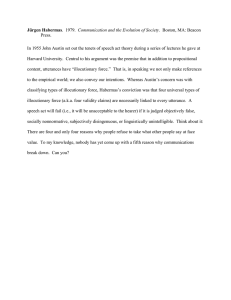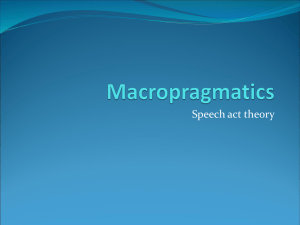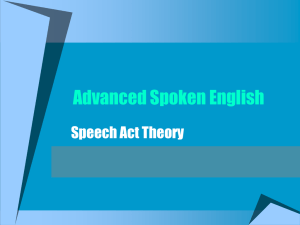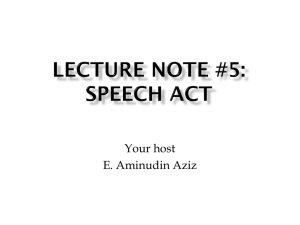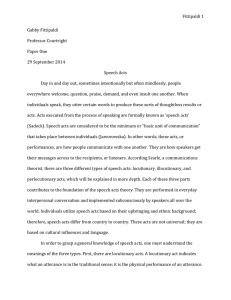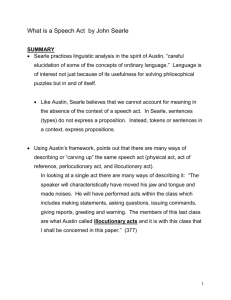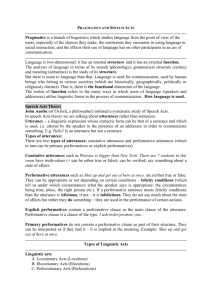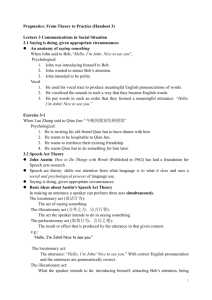ON LOCUTIONARY AND ILLOCUTIONARY THESIS 499 FENRY
advertisement
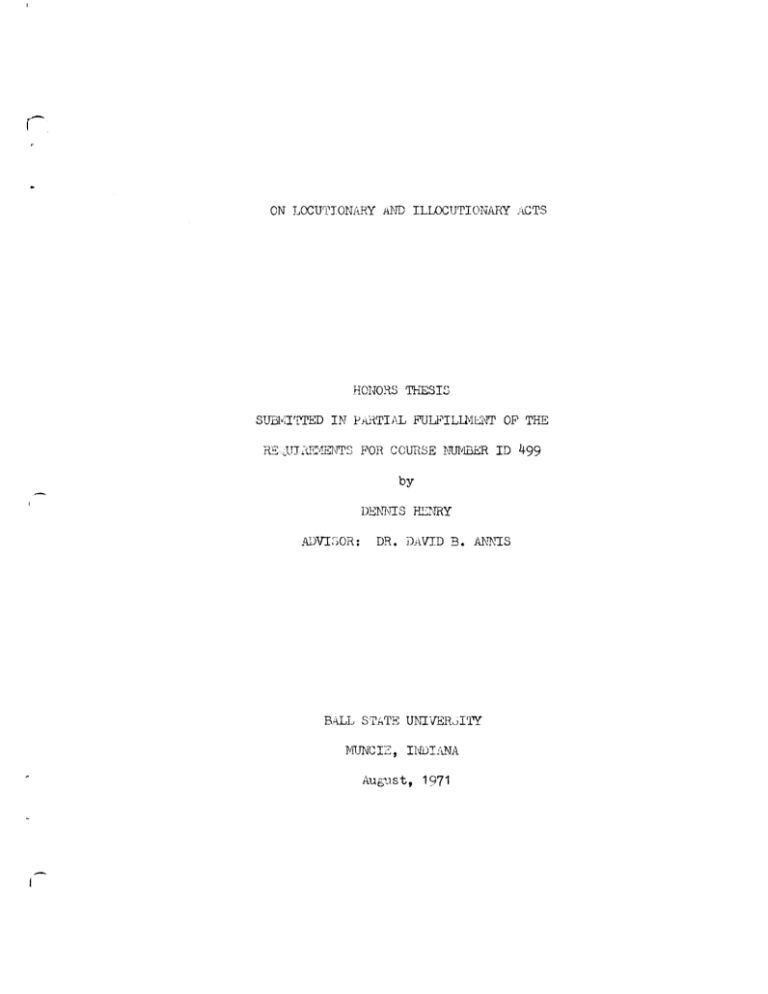
ON LOCUTIONARY AND ILLOCUTIONARY ACTS
THESIS
HONO~S
SUBKI'f.'TED IN PrillTIAL PULFILU1ENT OF THE
RS cUT :rr'!:"~iITS FOR COURSE NDrilBER ID 499
by
FENRY
DEKNIS
.4.DVI ;)OR :
DR. Di\.VID B. Al\TI\TJS
BALL STATE UNIV'€H,..iI'l'Y
ttTIJNC 1:2: ,
INDI~\'.~A
Aug;'JS t,
1971
r-
I recommend this thesis for acceptance by the Honors
Progra~
of Ball State University for graduation with honors.
Thesis Advisor
Department of Philosophy
August 17 t 1971
r
-
1'he purpose of this paper is to examine John L. Austin's distinction between lOcl1tionary and illocutionary acts (1).
This will he
done in light of cri tici sm offered by Drofessors John L. :3earle (3) and
L. Jonath!:tn Cohen (2), both of whom hold that imstin's distinction is untenable.
I will argue that the distinction may still be acceptable,
though i +; is probably more tenuous than ii.ustin believed.
Prior to propounding the locutionary-illocutionary distinction,
Austin had sugg'ested thp..t there was
':t
certain class of c.ec1arative sen-
ter.ces, naJTled by him "nerformat:ves," which could not be eorrectly described as being ei tiler true or false.
performa-~ives,
.cl.
person who utters one of these
Austin suggested, performs a certain act.
Of course, one
act that he performs is tre act of utterin:: the sentence.
performs this act, no matter Hhat sentence he utters.
performa-~ives,
the act of l1tterin,,' the sentence
j
act of
u-~tering
mad~. ~ .2!~t.
~!ou
But in the case of
s suffjcient to ::;uarantee
that the speaker has performed some other act a8 well.
Jones says to you "I bet
A s1}eaker
For examplp, if
a dollar," Jone8 '1-:"'.8 not only performed the
the sentence, but in sayiWT, that sente{1f;e he has also
His utterinfS the se::1tence is
t~~!e
actual 'pett,;ing.
In other
words, in saying the above sentence Jones h,".s performed a 1")articular act
over and above the act of sj.llDI:rsaying something.
bet you
Since his saying, "I
" is the bet, Jones's utterauf'e can not correctly be de-
scribed as being either "true" or "false," because l,-Te do not norma1ly
use thos!? terms to measure the propriet7 of acts.
not say of Jones t s betting you
th~~.t
Notice that vou would
the bet vIas t.rue (or false).
Similarly a nerson Nho says "I prorniee you that • •• " is not
only say:Lng a sentence, but in saying that sentence is promising.
By
2
saying "I promise" the sDeaker makes a verbal contract to do something.
Likewise ,. utterances of "I "larn you th8t • • .", "I order you to • • .",
"I request th'lt • •• ", etc. are acts of warilinr.;, ordertnls, requesting,
etc., and as such are not liable to be eithor true or false.
contrast to "constatives," Austin's term denotin;::;
t!~'e
This is in
class of sentences
which do not appear to be particular acts, and which are liable to truth
and
"J ones bet me th8t • • • f1, "I ran to the store • • .", and
fa.lsj~ ty.
so on, are examples of constatives.
They can be evaluated as being true
or false depending on whether or not Jones did, in fact, bet me, whether
I did run to the store, and so on.
the
sp~a1cer
ing.
In uttering one of tl:ese constatives
is not necessarily nerfoI"'Yling any act other than simnly speak-
For this reason, thE: true-false dimension appears to be an adequR.te
tool to evaluate t1--1em.
Hm'l shall
dimension?
vIe
describe perforrnatives, if not wi thin a true-false
.h.ustin sHg;pests that the notions "felicitous lf or "infelic-
itous" be used to describe them.
speaker
~mccessfully
If the circumstances are such that a
nerforrns the act in ma":inE; a perfor-nati ve utterance,
the utter::I.TIce i3 said to be "haupy" or felicitous.
Ii' circumstp.nces do
not allmlT the successful completion of the act, the utterance is said to
be "unhappy" or infelicitous.
dollar"
~rones
}t'or example, if while saying "I bet you a
0:'
if you do not agree to bet, the
"bet" can not be successfully performed.
Jones I s utter'lDCe is infeb.ci-
tous.
does not have a dollar,
Rut under no <'ircllmsta.nces would the bet be "false."
If, on the
other hand, .Jones does have a dollar, you do agree to bet, you shake hands
on it, and so forth so that a11 the necessary conditions for completing
the bet are fulfilled, Jones's utterance is said to be hanpy or felicitous.
3
~.
preliminary eXa2aination appears tc indicate that pErformatives
all follow a certain pattern.
Our eXaP.1ples of qerformati \res, thus far,
fEve 6.11 been in fir;3t person, Dresent tense, active voice, inriicative
mood.
F'urt~er:nore,
they have all generally followed the "I
___
It anpears trJ3t 1·;henever the snr'sti tution
that • • ." fo:rrcula.
(vou)
v
o~'
a verb
into t,hiE; for""vla generatps 8n accentable Ji:ncljsh sentence, th?t sentence
is n·eri'orrnati ve.
POl"
eX:"1.':.nle, 8110St·i tution-inst,ances suc1 aB "vm,,,-",
0
" co!:1'1land", "exhort" all generate accei'table 'Sn,-,.lish seEtences which are
BC!ts
donH in the sayi Yl~
~['his
that
80['\('
formula
ryf
1.rj 1.1
the sentenr>p.s.
not i<4",:"t:fy a] 1 n8!'formatives; Austin n0tes
se;!tences in thc' second
~~'('r"c;n,
present tense
al~'('
'.:l~alify
as
on pr:ivwl::.e nropert~T and liab] e to T'rosecu4:~.on. (signed) J. Jonc!s," 81-
The clas!') is then ex;)anded even furth?l" by inc1u-lin,:" "im:::,l;cii}' ncr-Porr.:lat:tvps as "t,he bull
if1
lent 'mr'ir?r certain
conoi~,ions
charge."
alJout to charge," phi::?h, ,Instin cC'n+,ends, is ecnivato "I \,'arn
7.'01)
The on} y chfference betllTeen the tiATO is th2ct of imnlici t as
opposed ·to ex')lictt nerf'ormance of' t}-,e act.
as IT'.'Jcn
t'!'1at the bull if' about to
'1
,-Jar "inE; as the J attpr;
1,,18
sjm~l~T
'l'h,~_t
iE', the fOC"':1er if:' just.
do not m::k", exolici t th'it ','e
are war-rein:".
Jl.ustin believed tbat the performatives
q;~d
ccnstatives s;'Ol11d
hro m1ltl''l11y pycl'wive classes of sentences, so tJ:'l2.t, t::iven any
dec} "lTati 'Ie sentence S, S
cOlll~
{"'Hi!
~a:rtic'Jlqr
be cats,,:ori7ed ej -:;her ::1-',. a T''''rfoY'''lJa.ti,ve or
as a. con3tative, but not both.
In order t:::: accomplish this, a set of
cri teria needed to be found vlhich 1,'!o1)ld be suffj.cient t,o distincuish
whether :3 "TtJ01Jlcl be one or the other.
'vocabulary rnight'lYlpear to be a good criterion, since it appears
that verbs like "run", "go", "convince", "attend" can never be nerformafive verbs.
guarantN~
Vocabulary as a criterion is not 3ufficjent, hmoJever, t,o
that a sentence if;' perfoY':':!ative.
"order", "bet", or "promise" 1·;pre
S
For instance, although "warn",
E'en to be perfornlc.ti Ve when placed in
the "I ___ (you) that • • • " fo rrllul a , none of these verhs "T,rill generat.e
a perforrnative sent·encA if they are used in sentences o-!' the !lHe
(you) tr.at ••
"type.
In the lat,ter type of sentence, tr:e speaker is
merely describing a particular situation"lnd that description caL be
either true or false.
Nor does a combination of vocabulary and r;r9-111r"lar
as a criterion satisfy il.ustin, since even this does not Serve to distinguish w:-:'y implicit performabves (as "The bull is about to charge.") are
performatives and "'Thy seeningl:r similar utterances such as "Jones is
going to the store, 11 are not.
Throughout
ou~
disC1JSsion of performatives, Fe haye relied on the
"fact" that constati'les were assessable as b",ing either true or false,
whereas peri'ormati ves could be 'neasured only in terms of felicity.
Per-
haps thie: difference could serve as a sufficient criterion to distin,9;u:i.sh
Hhether anyone sentence is a
~erformative
or a constative but !;,ustin
thinks that there are tvw reasons why even this cri terion
tinguish perfot'ITlatives from constatives in all cases.
v~il1
not dis-
First, it
a~pears
that there ar8 some constatives whj ch are more correctly described
l,ri trin
the happy-unhappy dimension th3.D wi trin the true-false diInension.
For
5
example, would you say that Smith's utterance was "false" if he said, "All
John's children are bald," \..hen John has no children?
Austin thinks that
what we should say is that the remark was in'3.ppropriate.
We T"ould not say
that the rerYlark was "false," but rather say that since John does not have
any cLilcren, the question of whether or not they are bald is beside the
point.
In other words, the utter,"lnce is "unhappy" in the same sense that
Jones's bet was
u1'"'~a~)py:
one of the necessary conditions for the utter-
ance being appropriate has not been fulfilled.
Secondly, the happy-unhappy dimension used to evaluate performatives is related to, ami de:;Jendent upon some notion of "truth."
Perfor-
matives, to be happy, must satisfy certain necessary condj_tions, as in the
betting exa'11ple.
But these necessary conditions are met only when they
correspond to experier..tial facts.
Just as "Jones bet me a dollar," is true
only if it corresponds with what actually takes place, so "I bet you a
dollar," is happy only if the necessar:l conditions (describable as "1 have
a dollar," "You agree to bet," etc.) correspond to what actually is the
case.
imstin concludes that there does not appear to be any criteria
which will separate perfonnat,ives and constatj.ves into two mutually exclusive classes.
furthermore, the method of evaluating one is quite simi-
lar to the metrod of evaluatil1b the other, since they both rely on a
positive correspondence with certain facts.
Underlying the breakdown of
the performative-con9tative distinction is Austin's belief that the notions
"true" and "false" on the one hand, and "felicitous" and "infelicitous" on
the other, are very similar sets of terms.
Both sets are used to designate
the degree to which a sentence may be said to be the correct or proper
thing to say l.mder t!"e prevailing set of circumstances (1: 144).
6
.flor these reasons, Bustin replaces the performati ve-constati ve
t~wt
distinction with one
he helieves w:i.ll set out rnoY'e accurately what
it IDsans to do sernetring in saying a sentence.
"I
Bill
60ini to t01.m."
Sup!')ose that Smith says,
HI" has nerformed what Austin calls a "s-oeech act."
'l'hat is, he has said the sentence 1.<,i th meaning and, stmul taneoUflly, he
has used the sentence to nerform a narticlllar act.
Th'3,t act may have
been a statement of intent, a nromjse, a description of
etc.
hj2
actions,
Tre act of' utt€r'inn: the sentence Hith meaning is called the "locu-
tionar:;! act"; the use of tl-Jat sentence as the perforr:1ance of some act,
its "force," is
ca~l'?d
the "illo,::utionary act."
Since, as ,'ile noted, the
10cC]tio':;u'v and illo"'utionary acts are abstrar.tions from th'? total sDeech
act, any utterance r,ini0.i1 a'lOlJ.Y't8 to saying something ,<Jill entail the
s,~paker':;
havinp: bo"=Y. nprformed a 10cutionary act '.nd an ';llo<:utionary
act bv h:Ls uttering the sentenC'e.
Bv
"mean';'1~':,
a
,. '\ust,in ey"",lains tP'1t he means "sense and refel'"'enc'?"
l"'~lrticlJ.lar t"'Tl,
one !TPanB or anothr'r to tl-:e
n,~qrpst,
means somet'li llil like this b;T
"."'0
and so on.
he USPS the
bur1!, tOFn, or city."
If :;,mith
to tm,rn," "-'" i:-: \Jsin-:- the Fords ,d th a
7
"m:'[l.I1:!n=" to b:: p("}11i~:'llent to the ),rorluct of the "sense" ;:nc1. +1<e "refer-
ence lt of the utterance.
1
r1he necessi t,:- of tr.e notion
to
fl.1 J9tin,
'inee
is~
iq
a:-~pareLt
it may 8+;i1J be unclear ae t.() hat-! Smith used that utterance.
viII not tell
AS
t:le "illocutionary act," acc"rr'ling
in that no (l'j,,",tter "_:hat the "meaning" of the utter-
Th::;t is, t,}'e ntteranr.e may have had
int~
00"
U~
tl-~e
"force" of a Ylr,,,dietj on, or else
1,!hich -i"orcp Smjth's 'ltt.pral'ce actu!llly had.
}<uythermore,
-=:.nd f18.ve used thEm T,ri th a diff"'rent force than he did on this occasion.
a res 1_11 t, any acccunt
necessartl~r
Fe
-vri 81: to make of a complete speech act must
include ('oth the notion of a 10;utionary and an illocutjonary
act, si.nce the sa."1le (or eoujvalent) lOC1.ltionary act rrIay be on two different
occa~;ions, t~"o diffe:~C'n+_
i llocutionarv acts. 2
The locutionary act is abstr ctable into
the phonic act, the
rh~-ti('
to t:1.e uttering of ncise.
act"
t:-~ree
and the rhptir. act.
different acts:
The phonic act, refers
"Flrmf oe," "sadly Jill have blue are," and
1Austin does not say exactly H~at he :neans by "sense and reference."
He says only that his notion is in line 1I'~lith current views." (1:142)
The q1J.estion as to Hhich current view he is referring, is unclear. The
terminology is F'regean, bEt IlUstin appar2ntly did not mean to follow Frege' s
analysis too closely, aF Cohpn points out. (2:120-121)
?
It may also include \-]hat ll.usT,in calls a "perlocl1tionary act," the
act effec·t(~d by t,hc; first tHO. For exa.'11ple, w;1en Smith tells Jones "Get
out," 3!;d.th performs a locutionary act, by utterin; t:le words with a !i8rticular f:ienSe and reference; he T)crforms an illocuti onary act by using the
utterance as a warning; 1:e performs a perlocut::ionary act by ca11sing Jones
to leave. Austin sUfgests the use of the
saying _ _, I _ _" formula
to distinguish them from t~e illocutionary "in saying _ _ I _ _ ."
"Ex
-
8
"row, ret-r, row your toat" are all exarnples of phones, and a.n utterance of
one consi;i tutes the rerf0rmance of a T)honic act.
']'he phatic act is the act of uttering vocables "conforming to or
at~
as conforming to a certain Cra'llmar, an:''< confort'1ing to or
to a
ceri~ain
vocabulary."
confnrming
.:.<::very phatic act is a phonic act, since every
utterance that conforms t,o a vocabulary and e;rmnmar is in part always a
series of sounds.
pret~y
Tr"2
converse, hm'lever, is not true.
"Nose go are
the tangerine" is a phonic act, but does not conform to a e;rarnmar
and thus l' is not a phatic act.
The actual vocables llttered in a sinzle
phatic aet is called a "pheme."
r.~he
rhetic act is the act of usine a "pheme" with a certain mean-
ing -,,:herE) "meaning" is equivalent to "sense and reference."
is the utterance made in the perfornance of a rhetic act.
A "rheme"
For example,
thelimrds "I am goi!1[ to town," uttered by some person who by Ill" means
himself, and who by "town" !Deans, some narticular town, and who understnnds
the use of the .Gn&:lish phrase, "go to tmm." is a rheme.
utterer'!
'~he
The person who
"lords with a narticlJlar sense and referenee h1.s performed a
rhetic aet.':'Very rr:etic act is a phatic act, belt not conversely, since
"the pha-~ic act is essentially mimicable, reproducible"(1 :96).
formance of the rhetic ac+"
The per-
then, constitutes t"f Hhole of the 10cuti0nary
act.
All this
i~
contrasted to t1:1e illocutionar;T act, a c'l.escription of
which te11s us in Hhat nrecise way the utterance is beinr: used on thi:
particular occa",ion.
and it maves a
~Te3.t
"There arp vo,ry numpr0'J"', ways in which 1:1e use speech,
diffe""pnce to our act • • • in Ti!hich Hay and ,.rhich
"sense" He were on tr'is occasion "using" it (1:99)."
Given Smith's utter-
ance, "I am gain;::: to do it," we may \,rell know ,\,rhat th'? senses of the Hords
9
thi~
are, and to what they ref?r, ani stj 11 be in doubt as tel "lhethpr on
occasion, spoken by th3.t nerson, the utterance wad really a threat, or
simnly a warning, wreth8r it. was a Clromise, or merely a statement of intent.
UDon hparinc it, we
promisi!1{£ me that •
mi:'~ht
1,rell Honder, "I heard what you
~iC!.,
but are you
. ..
?,.
•mat Austin has done, tren, is to abandon the snectal performativeconstaj"t:cve theory for the more f8neral locutj_onary-illocutionary theory.
The use of performative verbs in utt8rances serves to make explicit the
i1locutionary force of the utterance (1: 114).
The list of these s})ecial
sayin~
verbs ineludes, in edlern.l, all verbs 1"hich satisfy the "in
I was (doing)
---"
is to
or "to say
---,.
formulae.
---
'l'he problem
as to person is eliminated, since "he lV"arns that • • • " may be said under
the 10cutionA_ry-illoeutionary t:1eory to exnress the same force as "1 Harn
you that • •• "
Wi th the nerforrnative-constative distinction, vIe were
in the awbvard position of
C!las8if~ring
"I 1.'arn you • • ." and "he warns
you • • • " as tHO cOl'loletely diffprent kinds of sentences.
Jmstin' s
nreferer:':!e for tLe locutionary-illo·;utionary distinction appears to allow
us a
bro;~der
SCODe for characterizing an utterance of an S as also being
the nerforrr;ancp of a particul2_r act (apart from the simple act of uttering
alone).
Since all declarative sentences have some illocutionary force,
the noti-:m of what we do Hhen we say sometning, is seen to be applicable
not just to performatives, but, tc aJ.l utterances.
Still, an utterance
vlhich
srec:i.c~l
US2S
triP
"expl-Lcit ncrformative" is sO!!1€Hhat
"force" :)f the utter'3.nce
a~nears
Gince the
to be unirIuely determined by it.
.itS
"rill
be seen, it is this unique role that performatives play in h.nguage which
is the source of an important criticism of tte entire locutionaryillocutionary distinction.
10
A fair aJ:)praisaJ. of the locutionary-illocutionary distinction
v;i 11 depend in part on hOi, we shall interpret ,.,hat "u3tin means by the
illo'2ut;ionary act.
Just h"hat qualifies as an, or the, illo(!utionary act?
There seem to be at 1 east two possible inter-:>retatioT'.s.
Consider the
f'ol101..ing exaLlple:
(1)
I warn you that the cat is on the mat.
IJovT the locutionary act ':)erfoFicd is ttc u"::teri.n~· of the sentence (1)
v.'ith a certain more or less definite mcardni2;.
noint, but not co clear on 1,h elt the
illocution~ry
On the one hand, it looks as thoUE':;h we
cutionary act "Has one of IJarrlillP'."
10c1l"tiom~ry
act, ltJe rave not really
AU8tin is clear on this
act is sw::mosed to be.
~:li-=ht
say th2.t the illo-
If so, then in abstractiT'g the
ab~j;raciedth'2
i.llocut,ionary act,
al th01.wh tl-]ere is no q,u"!stion left as to hm.; to describe it.
Furthermore,
tile ab-t"''lcti.on of the illo('lJti.onarv Ret from (1) as one of ",'arr:ir.t:',"
in no ',rey
abstract~
t]-,e 10,',?1,tinnar:," act f'rC'T'] (1).
This is true sinc,," the
locutiom,r:: act is (:efined :i.n '.'art, b:'T the voc2,,'es 'Jt,+r:;rpd, Rnd o"e
nrt abst!"'ct,·d
an~/
vccebles.
~l::.1Ve
Cn this interpretat::0n, i -l: J OO~f' as tl--;oll['h
locuti om r~' <>,ri i 1.J.Oc11i:i0nary acts mnst ah'ays re 'Dllt"a!_ly exclusive,
since one act could never be
j
':'ent.ical to the other.
',.'e T(li["ht try i:0 cl'.1S+.:ify trj:" ;nternretation rm t:'e h? "'is th,?t tht'
notion "i 1:'02'I-l:jon" is •.<:fter
simply
b",CalJ~p
the
10~'ltion
8,1~.•
is a
aT' abctT'h,ction, and to (iemand that
ph~rsical
act"
-I:h:'.t l.t rnust be t00,
11
C'r
FE'
mi<,;ht
the followine::
Aay
Of course thp concp.:;ts "loc'.,tion" anr'! "illocution" a.rp di ffer~nt.
If
H~
rAlTI?in on the conccptnal l':?veJ in ciescrihjn": the locutjonary act
and the i llocutionary act of t,"'e 'ltterance, certainly
mutll2.11y excl'.l:c-i'TP.
+0 abstr:cting
t:~p
But
"de,'cri.btn:~"
t~ey Hj
11 ahrays he
the acts concept,nally does not, a'001.mt
acts fron a 'JJ.rtj_cular utteraDcP.
~·.nat ts the i lloc',_'ti onary act T)eri'orDed in the utterance of
B'At th:::.+ rpnly is m'?r'?l:r a conc2ptnal descri:rtjon of
+~~.e
8ct.','<11&,t is the
actual i 110cutionary act on tti,,=, occasion of that ',ltt n r"tnce?
of (1), t:-e
illoc'ltionar~'
(1)?
In th2 e".Be
act i ,s Jones's use of the ut,terance "I warn you
+;rqt the cr:lt i::: on tDe 'll&t" as a "arning to Smith.
tionary act performed on that oC'c9.sion.
That is the illocu-
The illocutionary act must ah:ays
involve the actDC'll utterance, w"en there is one.
'I'hrour.:hout the remainder of the paper, we will discuss the
10c'.ltionary-illocutionary distinction in terms of the latter interpretation,
since batf'. Cohen and Searl!? seen to interpret Rustin roughly
way.
j
n this same
Furthe!"lClore, the first interpretation is singularly uninteresting:
on the conceptual level, the dist,inction 1.nll al'\<ra:,'s r.old.
The first fl'J.8s+,j.on that presents itself is whether or not Austin
intended for
lOc~ltions
and illocutions to be mutually exc1.usi ve.
To say
of TIm things that they ar'2 IIYr1utuaJ.ly exclusive" means in t;enerA.l that the
intersection of the t'.·TO is equal to the null class.
AppHed to Austin's
dist,inction, we should say that the locutionary act and the illocutionary
act "ri th reSDect to a sentence S, are mutu:llly exclusive if allY abstY'action
of the locutionary act from SHill not be an abstraction of the illocutionary
12
act from S, and conversel;T; tllat is, nothing is both a locl'tionary act and
an i llocutionary act Hi th
respi'~ct
to S.
de mi,::.:ht suprlQse that 'lustin did intend fer the tHO acts to be
mutually exclasive, as he continually SUEtge'Sted tha,t force and meaning
are to be contrasted.
If he did not intend that contrast to be comnlcte,
he does not menti on anY'-There in How To Do rrhinc;s with Hords this reservation.
Si~ill,
he nm-ihere stC'.tes that he does intend for tre distinction
t,o be rnu-:.uall:r exclusive and notes (1 :148) that there remains to be done
Il
some weeding-out and reformulating in terms of the distinction.
So it is not ch'ar j1\0t "rhc.t Austin intended.
11.S
"
a result, we will ex-
amine the 1 0:::: uti onar~r-illocutionary distinction as if it l;lere inte{'.ced
to be mutually exclu;live and, if it is not, atteL:pt to find a:aother,
weaker,
:~el3.tionshi.p
that wjll hold and still be ,,'i thin the general
i~ide­
lines that ,.\.ustin has constructed for the distinction.
j'{elated to this problem is the question of how 11.1Jstin intended to
determine the "meaningll of any p:i ven ')tterance.
1tihen dealing with sell-
tences like
(2)
The cat is on the mat
uttered 'd th sense ,'J,nc refer',,;lce, it seems to be Austin's intention that
the "m?cuing" of (2) be determined in refercrce to +,he utterar'ce as a
whole, as opposed to ,iust certain words or a certain part of th., utterance.
However, when dealinff with sentences like
(1)
«) I warn
Y01)
that
' ) the cat is on the mat
where Jt denotes the "",rformAt.i'Te pref1.x "1 1i;-arn you" and ,
denotes the
subordin3te clause--i t ie unclear as to whether Austin j.ntended for the
"mee,ning" of (1) to be determined solely by reference to ,
' or by the
13
v,rhole ser.tence; i. e. whether hy -' alone, or by d
and ,
together, in
that ordEr.
j.t first:;lanc:e, this question looks trivial:
after all, if the
meaning of (2) is determ.ineCl bv the Hhole locution, surely the same method
mU8t be E.nplied to (1).
stat,~d
that the illocutionary force is ma.de explicit by 1.lSe of the perforThi", rw.,ans th&t in t"be ccwe of ser1 teYlces like (1), the words
matives.
It
a
Em·!ever, it should be remembered th.Jt il.ustin
I \-Tam
are eX'81:ici t evijence thE~t the illo~utionary
force.
of (1) is
.
YOU"
"
.
V1arnin~;.
NOH
if rnf'aning is deter:nined by the whole utterance, then it
looks as if "meaning:" and IIforce" are not mutually exclusive.
That is,
in atter:mting to abst.ract the locutionary act from the utterance, we
voulrl
i
nc'.dvertentl:' be abstractin: the i llocutionary act as Hell.
In re-
Dorting th8.t the 10cutionaY'Y act nerformed in utteri nc (1) ,,,as the saying
of the sentence "I ",arn you that the cat is on the mat" wi.th a particular
sense an.' reference, we have als.2 reported that the
Has a wal'ning.
illocut~
onary force
The semantical stn:.cture prescrib9s that the force
must be a TNarning.
0:
(1)
1·\U't.'!;ercore, any abHtr<wtion of the illocntionary act
app·?ars also to be an abstractj on of tree locutionary act:
any abstraction
of the aetual 1--Jarnine of Smith via the utterance (1) neces~,arily abstracts
the utterance v-Ti th sense and reference.
Consequentl;v, ",f m2aning is a function of the '.Thole sentence, the
meaninG-force distin("'tion, and corresoondingly, the locutionaryillocub.onary distinction can not be mutually exclusive, since all cases
li~e (1) ,,,here aL exolici t
performative is used, any abstraction of one
act will be the 8bstraction of the ot:'er act.
that meaninp: is a function of the
}iYJd v.Jhat if ,'Ie ,,;ish to hold
jJ clause alone?
Jonc,than Cohen lists
at lEast two reasons why he believes this interpretati.on will not s1..1ffice.
14
First, he -reasons that (1) and (2) must be
tionary acts, since t!",e locution
certain vocables.
i_f'
different locu-
hlTO
defined in part by the uttering of
prefi~-:: {;I(
Therefore t:le addition of a perfonllative
to
(?) r1ust bl? a differellt lo(!utionary act from just (2) alone.
Secondly, given that
eve~'
illocutionary act is a locutionary act,
then \,r'rlenever ;,Ie utter certain "self-sufficient performati ves, n (perf'ormatives which by themselves constitnte a complete sentence, such as "I protest," "I bless you," III nominate Smith") thpy not only have an exrlicit
fo-rce, blJt alf,o a mea'iing.
f3ut Hhat is the difference betHeen t:'l::; force
---
of "1 protest," and its meaning?
The:' a;mes.r to be the saDe.
are i,re to aSS'llI'1R that the
nref:'..xed to some ,
l'!'leaning it 1',';:.0 ,dwYl uttered 2,10ne?
pprfon~'1ative
ImQ
"Then
loses tbat
If not, meaning is not a Lcnction
solely of the subordi,late clause (2:122, 123).
'1'0 the first objection, we should re01y that (1) ':in-' (2) must be
c:ii'ferent locutionary acts since ti1ev are COD'i:Jrj 2ec1 of' rli :f'ferent phonic
acts--?n~
HO~1ever,
corres:'ondinp to then, different phatic acts.
ohjection h,'? r: n f'orc0, p·o to sne3k, 1m1ess
1tr
e
8~'~'ply
t,he
the
aDrarel~t,ly
in-
"But then it f:J11ows t '-:'l.t, tr·'?;t ar'" different rheti(' acts, frnm
'.\Ty,ic': it f0110"11T8 that (1) <m--1 (2) mnst }love different, me,q.::ings."
Certainly,
only jf
R
sjn('~
8
"rhpme"
p2.r+i,cl112r1y
L;-lef~'1ed
in t.:::rr:ls of +rC' nntion "che:ne", and
underlytn~' P,?Sl1F'I~,tion
is tru'?:
no rhctic act
CEm
15
to this tYT"le of situation, that of "rheticall:r ec'-1ivp.lent" act8.
that (1) a.nd (2) (or (1) and
tantamount to asserting
th~t
J
To assert
of (1)) are not rhetic3.lly equivalent is
they cannot have the same sense RJld reference.
But t.hat is assertin.; that "meaning" in Austin t s sense must range over more
than ,just the subordinate clause--and tbat is moot.
The second objection
is more difficult to answer, as Cohen notes (2:12?').
There is, however,
an avenue we may take in reply.
';Ie mizht ask if these "self-sufficient performatives" are so self-
sufficient after all.
complete flr)eech act?
ThP,+ :iE',
do thsy comprise in and of themselves a
They do not look very complete.
Nost appear to be
simply elliptical expressions, convenient short-cuts wi thin a
lan~:uage.
Still, when faced '.,Ji th an expression like "I protest," even if
those are the first ",--::rds He hear of a conversation, we '.Tould not want
to say that the eXI-'ression has .!1£ meanin::r.
l,~e
to "protest," although l'Ie may not know what the
cause.
do understand Hhat it is
'~rotest
is or even its
B_nd if we gra"1t even this much, then whenever one of these -per-
formatives is D!"efixed to a
P clause,
we Hill have to assert either
that, whatever meaning "I Drotest" had Vlhen uttered alone, is nOH 10Ft,
or else agree that "msaning" not be a function solely of the subordinate
clause.
~~e
latter choice is eminently preferable, since even if it
,-reakens ..-,ustin's distinction, at least it does not sugfest the magical
"noN-i t-has-meaning, now-i t-doesn' ttl characteristic which
t~'1e
former
appears to have.
In general we should say that although
l-'1e
have dtsmissed Cohen's
first objection, we h."lve not had such good fortune l.Ji th the second.
Our reply, though not without 80me mert t, is ad:ni ttedly VJea};:.
as though given a particular utt2rance of type
C(Jl
It looks
, i t s (explicit)
16
illocutio:'lary force is r'21ated to or included in its meaning.
Consequently,
it appears that the locutionary-illocutionary abstr:"ction cannot be mutually excLlsi ve, in thp. sense that
~
propos to certain kinds of utterance,
one cannot be abstracted ,:.n.thout abstracting, at least in part, the other.
CJhe'1, hmv,=,ver, asserts tilat the distinction is even less clear
than this -oreliminary examination of oerforP1c::.tive utterances 1N!Juld indicate.
The notion of "force," accordinc to Cohen, is unnecessary, since a clear
notion of "mea'1ing" w:ill account for everything about an utterance that
Itforce" is intended by Austin to account for •
• • • it is pretty clear thct jf you address the EYle'1lish
sentence "Is it raining?" to your friend, as he looks out the
windm·.[, your me~~ would be made even more explicit if you
added a moment l'3.ter, "I aSK Hhether it is raining." • • • in
your first utterallce, let alone in your second, it is il!!2.0ssi'ple ~o distinl'-:1listl force from meaning. (2:123)
r.~e
have agreerJ that Cohen has shown in the case of
ex~lici t
perfor-
matives t,ha,t the locu':ionary ar!.d illocutionary acts are not seDarately
abstractable.
Here, he i3 <l."":+err:pting to broaoen that crtticism t.o incluc1.e
all ut+,erances.
!-1e is arcsuiTl[': that just as in the case
0:
the nerform3ttves,
there is no ahstraction of the force of "Is it raining?" wh:ich is not
really also an abstraction of the meaning.
!'!ote, hOHRver, that "your meaning" is used as if synonymous with
Austin's "force," i.e. it. answprs "how were you usiE:Z, the utterance?".
The ob,jection becomes clearer when we repl"l-ce "your" b:y "the."
we say, then, that the mear'.ing of
to it?
p
Is the sense and reference of
or just different?
the :2 Rnse and
viculd
is made more eXDlici t by prefixing
.I
mane more "explici til by
0(
0<,
Does the addition of "I ask • •• " make more nrecise
referenc~
of "is it raining?"
It would seem as if it does,
only if such physical nuanCes as mood, tone, cadence, and
er~:phasis
are
17
not force·-indicators as Austin suggests (1:7:3-74), but are sense and reference indieators.
If they are, then an utterance of,( 1'Ji th a narticular
cadef'ce, ,=mphasis on certain Dhonpi3, and "ri th a certain tone and mood may
well be s.odd tc) have a "meaniw:" beyond that of the rhemes.
In this case,
we could .3ay that "meaning" is ma."k:e more ex:::-lici t by the addition of a
particular performative.
fluous.
\·1hereupon, the notion of force becomes super-
If, however, these nuances are not functions of sense and reference,
it woulc. '')e improper
+.0
speak of "the meaning" of "
plicit" by the addition of 0<
the "meani.ng" of
All
being made "more ex-
It would be more correct to say simply that
"differs from" that of ,
(as shown earlier.)
And we
have no r,~ason to supnose (assmning these nuances are not sense and reference
indicator:3) that this differc:nce is one from "implicit" to "explicit," as
there is ,'lOthinp in the sense and reference of "
to indicate a hint of a:1.Y
"implicit" meaning to be explicated.
F'llrther, it seems as t:ough we can distinguish force from :neaning
in "is it raining?" and possibly also in "I ask v-rhetner it is raj.ning."
nnalyzing the former as necessarily havinc the eX:;::llici t force of the latter,
i.e. that of asking, :i.S similar to assertin2: the sar:le relat:"onship between
tilt is raining" and "I say th3t i.t is raining."
iYl.'~"?
Pe::'haps, in an indetermin:::.te sense.
explicit how we are using the utt.erance.
been lrlarn:Lng, stating, etr..
quiring,
t~xar!lining,
1
Is trle force that of "say-
But "saying" docs not make
In Ifsaying,1f we may well have
Li kewi se, in "asking, " we may have been in-
quizzing, catechizing, and so forth.
1"Saying ll is not illocutionary. l'his seems to be the reason Austin
did not include it as illocutionary. l/Jhy he included "ask" is puzzling.
(1:94-5,8)
18
But Cohen's question runs deeper than our analysis sugeests.
Cer-
tainly context and occasion playa role in determining the reference, just
as context, and occasion (via. mood, tone, cadence, etc.) playa role in
t~e
determininp- the force.
1,\ihr:n viewed in this light,
explici t the force"
"makini'" prpcise thl? mea'r.ing" tend to merge into
a,lO
matters of "making
the 00mmor: !lrobJem of deter-:1ining (in n8rt via context) exactly what l.t
is that wp do when vIe say s8mething.
There seems to be
R
di'lrj.ding line th"tt <'an be drawn 'between mean-
ing a.nd f')rce, but the value of Cohen IS
8r
guments
is perhaps more arbitrary than we had hoped.
j.'3
to show that this line
It does seem nlausible that
a not,ion ::>f "meaning" could itself handle both the notions of sense ':"10
referer.ce and of force.
thin~:s
mood, tone,
R,C!
urob"lbly
,~ven
But
+'~'e
"":T,hasis, se":::'e, rpference,
carje~~c""
intent unde!" the
One nrobl'?m t 1"at thi '3
wOt~ld
r p Q'.11t of this woulrl be to inc1uc',e sHch
S9Jl1e
~'estllres,
general "meaning-f 1n-;+ion"," hear:',ing.
1
entej 1 is evidenc"d with; n Cohem L, article
sense anci reference" and "me ani nr;'t as "I meant it as •
It
blqrrinp: of the distincb.on beh-Jeen what, sentences "mean" a::ld
speakers
tt
1"-:,\
Tn~s
i. s
P
H~at
mpan " in llttprinv t1l em.
a resl1lt 0:" Cohen's crjticism we have tentatively conclnded
that ltd. tr resr'2ct to PYDHci t
t:'on2r-:.' <l(?t9 are identical.
the other"
p.nrl,
perforrnatiw~s,
t,he IOC'.ltionary and illocu-
One can n0t 1:,,:; I'Ib·<;t;r8ctpd "'i thout abstracting
With res::Jrct tc 1Jtterances with other tl'cm an
e~·.:'licit
perfor-
mative na-:ure, Cohpn has sh0':JTl onI;: that if mood, tone, cadencp., etc. acne
eleID P l1ts of m'?ar.inv, is the A.bstracti.on of (me act the
other.
If they are nr··t, his argument is jnconclnsive.
ab;~tr:~ction
of the
19
':earle t:;ok
8.
soml?',rh3t (Efferent, thOlWh reluted, path in arg-'uing
B.2'ainst th'? locutionary-j 110c"ti onary di stinct.ion.
Hi s ar€!ument may be
smnrrnriz"d briefly +;h.3.+. since reC"0r+s of r1-:c:tic acts invariably contain
iJ,loel1t:'_cnary verbs (at least
0:
a very ~enp!"al t,ype), every cha'!'acteriza-
tion of a rhetic act ;,·rill also be a char3.ctertzation of an illoct:tionary
act.
-md since every sentence has some force-tndicator (such as grammatical
structure, tone, mood, o:'!tc.) b')i 1 t into its meaning, every s:ecification of
a locutionary act Hill determine a slJ8cification of em illocutionary act.
Hence, every rhetic act is always an illocut,ionary "lct of onp kind or another.
All members of the class of locutionary acts are then members of
the class of illocutionary acts.
To see just Fhat it is ths.t Searle is arguing, consider our old
example:
(3)
The cat is on the mat
(4)
He told me thLl.t the cat is on the mat
NJ1>J
any utterance of ("'J) is at least a ph9.tic act, since (3) is
a series of vocables "hi-;h conform to a particular vocatn.1J ary and gra"1Jllar
(English); corres:,Jondingly,
U)
is a pheme.
(4),
on the other 1"and, is
a report of a rl1etic nct, since the use of the phrase "he told me that"
implies that "he"
'lttL~red
the r'articular
~~Tord8
1.-ri th meaning.
Notice t;la t
if a parrot !lad squawked out "The cat is on the mat," one ','ould not say
of the
paJ~rot
that he told me th'3.t t,he cat i:3 on the
m.~t.
Similarly, we
would not say of one who merely stumbled over the English words without
using then to refer to a particular cat and mat, or who did not understand
what he \Nas saying, that h<:: "told me that • •
. ."
The use of the indirect
quotation report implies that. "he" did utter the sentence with meaning, i.e.
that "he" performed a rhetic act.
'!'hus (4) is the re')ort of a rhetic act.
20
The point Searle is making is t"l-::lt it seems for any case H'1ere "e
wish to repo:::ot a rhetic a.ct "Je invariably use verbs like "told" "asked
",hether" and so on.
tionary
only
v,~rbs.
Unfortunatel~T,
0earle claims, the verbs are i110cu-
Trey are "morp ICeneral" illncutionary verbs, but that is their
diff.~rence
from verbs like ''1,-Jarn'' "order," etc.
}:t'or example, the verb
"told" indicates a particular ran,:::;e of forces of Hhich the actual force Hill
be a member.
"1'."arni1¥';," "stating," etc., are some possibilities and are all
"species" of the "genus" verb "telling."
So then
(4),
according to Searle, is also a re:port of an illocu-
tionary a.:!t in that it ma.kes explicit that the force of (3) is "telling"
or is a s?ecies of "telling."
T'1.ere are h:o oojections which can be made to thie first premise
of the ar,:?,Ument.
First, is it necessary that reports of rhetic acts con-
tain these supposedly illocutionary verbs?
Remember that Austin did not
include them since they did not make explicit "That force
~cula:~
occasion.
On
l:IJlst~n' S
"T118
used on a
interoretation we may infer thilt the use
of -cheee 1tgenus" general illocutionary verbs served the ::,urpo8e only to
relate th2 fact that a particular pheme (3) ~ used Hith meaning.
use of the verb "told" \,;ould indicate tilis since,
t-'
'rhe
or eXB..'?1ple, "J'e would
not :::ay of a parrot thC',t hs "t,old" me that • • •• f!
Theoretically, Austin
coulc as 'Nell have distinguished the d:i.ffer,ance bet'heen the rhetic and
the
phati'~
by using
(4')
He
---
me that the cat if: on the mat.
where _____ merely indicates the fact that the sneaker referred to uttered
some phra3e (the sense of prich is denoted by the
fl
clause) with meaning.
Here the .___ is roughly equivalent to ,,,,hat might be called a "forcen"utral say," so that the iriea that a meaningful uttpr"l.nce has occurred is
21
conveyed Nithout that conveyance tipping the hand as to what force or range
of possible forces was used.
Secondly, the labe1_ing of (4) &s a report of an t llocutionary act
ex:~lici t
is faulty.
(4) still does not make
was using.
This is the whole puroose of the illocutionary verbs (1:114).
what particular force utterer
That is, (4) would not s1)ffice as a description
since the questton as to what the force
~,
o~
the illocutionary act
is still open:
\'laS he warning,
admonishing, or merely stating?
B11t Searle I s question mirht be put in tl1is Hay:
Is it possible
for Jones to relate tllat ;:,'mi th uttered S with a meaning '"ri thout relating
at the sane time some force-indicator involved in thl? utterance of S?
If
not, t!1e =_ocutionary-i llocutionary distinction wi.ll be weaker than \,.,re had
thought,
~lince
in all utterances the force will be determinEd, at least in
part, by the meaning.
The anstoTer, hOl-Jever, a-.;·pears to be "yes H
(1.f")
Jones:
and h·:;; did so
Now
va th
(4")
:
Smith uttered the vocables, "the cat is on the mat,"
a rrore or less definite meaning (as sense and reference).
reports a rhetic act in the same Fay that (4) does, and
yet does not commit Smith's utterances to having any partiC!c.lar force.
Normally iIIre don I t talk in the manner of (4 n ) .
Nonetheless, the fact that
it is possible to report a rhetic act in this manner is sufficient to
show that the fact that we do use these "general illocutionaryl1 verbs is
more aptly described as I1linguistic convenience" than a.s a '1ecessary fact
of lanFuage.
:)escribed as sncb, this relationship between the report of
a rhetic act and the re":Jort of an illocutionary act is clearly contingent,
and, cons8Quently, of little value as a tool to discredit the locutionaryillocution'l.ry distinction.
22
Even so, Searle might argue, any ut,terance of (4") Hill amount to
a specification of at least a ranse of possible forces for
(4"),
since
the Plood, tone of voice, etc., as well as the grar!lm:cttical structure, are
determinants of meaning.
For Searle, as for Cohen, mood, tone, etc., are built into the
meanj~
of an utterance, even thouo;h for Austin, as we have noticed, these
latter are force-inai
~ators,
and as Auch are in contrast to t,he meaning.
This, however, brings us back to the same wall we ran up aga.inst between
Cohen and Austin.
If we allow r.1ood, tone, etc., to be meaning-functions,
then it looks as if "c1.lstin' s distinction is unnecessary.
did not classify them as such, and if they
~
Austin, however,
not, the distinction is
much more viable.
What about the i?:rammEitical structure of the utterance?
Searle
asserts (3:412) that even the "old ?rarmnatical categories" such as i.ndicative, im:;eratjve, and
tionary force.
...rill serve as indicators of i1loc11-
interro~~ative,
'Phis is not so sure
8
test as i t
mi~ht see~:
(5)
"Is it really right(?)" spoken 1dth a certain righteoUS air
(6)
"He's dead(?)" mUJ:1bled by a new widow in shock aY1d disbelief
Austin asserts (presumably in refeY'ence t,o exar::ples of thts type) that we
conti.nually debate "w'1ether
01'
not they have the force of a question. tf (1: 99)
Certainly in t>-lese cases there is room for doubt.
(Sh("'ld I ansl..rer?
Is he
aski~ me?).
On 2:earle' s sirle,
j
t f!hould be n0ted tront the rrra-:'matical structure
does eliminat,e t,1-:e pOSRibility that (5) or (6) could be,for pxa""CJlE·, a
Dromtse
OY'''
"'",~u,:st.
of nerO'on, et.c., i
<'
In
0+~pr
worns, the combim'.t.-i.on of ,·,ord-order, choice
s11fficient to eliminat,e a few
p'yc;C'i.b18
forces.
So He
must 8,} lm\r that the '2'Y'am'TiEl+:j c~~l rrtT" l c+,l):re dops serve to "indicate the r8:-.2,'e
23
of pla.usible forces, 11 in the very broad sense that it elimimltes a handful
from all the possibilities.
Given this, 0f~arle' s arr~ll1nent (if it may be ";eakered as such) t.ha+.
ever:i re::':'lrt of a rhet;ic act will serve as a report of the .£ossible ranee
of illocu tionary force seem to hold, t.hnugh not "lith such strength as
Searle believes it to.
The question, then, is whether this constitutes
suffi.cient grounds to assert tt'c.t: t.,e locutionary-i llocutj onary distinction
breaks complet.el;' apart.
Before ",Ie tackle this question, Searle's mill
brane of the riistinction deserves a brief look.
::.:iearle sugr,: sts that we replace the rhetic act with thp propositionEl.I
act, lithe act of expressing the nroposi tion (a phrase v.fhich is neutral
as to illocutionarv force.)"
(3:420)
By "proposit::'on" :3earle is referring
to the I1content" of a sentence, but aoparr:ntly only that "content" ,!Thich
is force-neutral.
'rhe taxonomy of the speech act '.\Toulo i,nclude the phonic,
phatic, and proposi tinn,o,l a.cts on the one hand and the illocutionary act
on the other.
The pr'Jposi tion would have an advantage over t.he rheme, i.n
that the prooosi tion is not a sentence, and ,.rill not ther2fore generate the
problems '>Ii th punctuation (and, presumably, oth8r ,?'rarr£1atical structure)
tha.t the rheme does.
Furthermore, since the proposition is neutral as to illocutionary
forcE', whereas the rherne is not ah:ays, the t1'1O acts (proposi tional
a~.d
illoC'utionary) will be mutuall:' exclusive.
The "arlvantagps" of the proposition look, on my vim", to be quite
inconclw:;ive.
If the proposition does not include the force-inriicators,
then in an utterance of th8 explicit performative type (III protest
that
13
I,
11), are we to assume that the proposition ,
'\'
is the sale bearer
24
of meaning?
If so, then we should ar[:,ue, as did Cohen against Austin, that
we are fa.:!ed with having to assert either that "I protest" uttered alone
has no mroaning, or else that it "loses" its meaning wren prefixed to any
typical clause.
Neither choicE', as He have ShO\;in earlier, is particularly
desirable.
'l'he "proposition" like the "rhetic ar.t" must still be exrressed in
term~,
of some phraseolop:y from which (thoug}' He may conceivably eliminate
the punctllation) a \-mrd-order ernerges--and as we "helve seen, this \-rord-order
alene is slJffici"mt to rJetermine (in a vleak sense) the range of possible
illo(utionary forces.
not
mt1tuallyexclusiw~,
rrherefore, if the locutionary and illocutionary i'll'e
it does not, look as if tr>e nropositional-illocutionary
disttnction is mutually exclusive, either.
30 it is nrecisely whrore Austin's distinction has been weak that
Searle's repb,cement has fared little better.
The question for both ac-
counts is \..hether or not these difficulties constitute sufficient, !Srounds
to dj.smiss the distin:::tion.
Thus far we have seen th2.t, Austin's locutionary-illocutionary distinction can not be mutually exclusive, sjnc:e in utterances of the exnlicit
performati ve tyoe, the force 0:' the utterances a:r-nears to be included t.ri thin
the meaning.
Furt1:J.ermore, in a:,-y utterance, certain factors relative to
its meaning (its p;rarnmatical structure) may serve as indiCA-tors of the
posstble illocutionary forces of t,he ut,terance.
This IG.st, however, is
qui te a bit Feaker thl,n Searle's conclusion that "Ever:! rhetic act is
ah!ays an illocutionary act of one kind or another." (3:412)
conclusion seems too stron£.".
It does
"1OT,
But Searle's
follow from thr) fact th"lt a
characterizat:i.on of one speciftes the range of the other, or that a report
of one specifies the r an"::9 of the other or eVen that a report of one is
25
the same as a report of the othE'r, that one is the other.
And the evidence
given on1y supnorts the former.
'T'hus far, we have assumed t"'!at, e;iven our 1atter interpretation,
the locutionary act and the illocutionary act for an utterance of a "performative," such as
S1:
I warn you not to touch her.
were identical.
the other.
dist:.nc~ion,
That is, we could never abstract one without
~;round
2:ven so, 1-Ie did not find sufficient
abstr~cting
to dismiss the
si.nce for all pther utterances which are not explicit perfor-
m[.tives, such as
S2:
Don't touch her.
we seem to be able to abstract the locutionary act without abstracting
the illocutionary act--the Dossible excention occurring if 1ve arbitrarily
decide to classify mood, tone, etc., as elements of meaning.
A re-examination is needed, hOt,rever, of our origina1 position on
the jJ1enti t;r of locutionary and illocutionary acts in an utterance of S1.
'There is some reason to believe that the 10cutionary !'.nd illocutionary are
never identi cal.
The first clue that something might be wrong is that
under the second int€rpretation, the lOc1ltionary act of uttering S1 with
sense and reference is the Harning of Smith (illocutionary act).
should lead us to ask why, if JJnes utters 3
2
This
cmder Bppropriate ci.rcum-
stances, wouli tl:e loclltionary act of uttering 3
2
v:i th sense and reference
not be the ".,arning of ::imi th (illocutionary), just as it was for 3 ?
1
The reply to this question should be that there is a crucial difference betl"reen 3
1
and 3 :
2
Any ser:i.ol)S Ii teriil utterance of S1 entails
that S1 h9.ve the forcp. of "Ta.ming; not every serious literal utterance of
3
2
entails that 3
2
have thp. force of l-rarning.
In other ",ords, the utterance
26
of S1 1"Ii tn sense and reference is the warnin:o:.
sense
3.n~
refereD.ce is not by itself a Far!'inc.
ind~.cators7
with
2
It needs certain force-
such as mood, stress, et,c., as Hell as context-refprc:-:ce, accom-
it to qua} ify it as a T,;arning.
nanyin"
But t,he l,ltterance of 3
'rherefore, the lO(, l1 tionary and illo-
cutionary acts of S2 are identical only if these force-indicators are ac-tuc.lly part, of the locutionary act.
To put, i t
to Sr"
ce,
anothi~r
t~e
Hay, wi t1-1 reference to S1' the aci;. i nvo1.ved is
i~'
hC"Jevr'l', -t:he a0.t involvpd
0C'casionJ)i::-l-,t not be a "J3r>,ing.)
"'n !:tcdi tiC)naJ 2.ct:\'[e warn.
the physical utterinc,: r.r:l tll sense anrJ
It, is in ttis sc:nse that '·)e may ahstr2.ct.
Gertaj.nly t:,ere are overlaDs, but the abstrac-
tion of +,n,e 10("-1tion8.:':1 act of S,) "\>Till not T'E'vc;al its unique force.
£.
But tl".en '\tJ1r.a+, is it about +;r:e i 1lo0.'.1tionary act of l.'t.terinc; 3
2
th2.t
~?,kee
i.t
'let?
A:'D:lrcr.tl;;r S'J.ch t:-tin::-:s as mood, +onc, streFlS, P.t.c •• plus th8 occasion
mak'? it
9.:"'1
';'.~l
art act."
.£S:t, and at, tlY' "ame time sets 5t anart from +;he locutionary
ar.t, af' opposed t:J juse a referpnce to the
Thl)S,
somethin~ ~nre
tte
10r.'.ltionar~' .qr.c.
tha~
~onc0:Jt
tllocutjonary Ants
1 •
just Jones' ma.nng
2.:1
,.'j
"illocution-
th referEnce to
utter:tnce of So')
,-
1,rj. th
sense
and refer?nce.
'i,ha+ then about 3 ?
1
Are the locuttonary and illocutione.ry acts
:nerformod in the utterance of 3
1
identical?
~~ertainly
an 'ltterance of 3
1
27
,vi th sense and reference is s'Jfficient to
least as
Ii
1,mrniner.
because The
USA
1
is uc:ed at
But are mood, tone f st,ress, etc., to he iznored simply
of tb!
nature of the force?
uarantee that 3
~erforrnative
verb
l~~aves
no room for doubt about the
1-1:: seems that if 1'le are to depend on the1'le force-
indicators ta determine the illocutionary act in S2' we ought not to completely d:Lsre[,;ard then with reference to 3 ,
1
'That is, there is more to
Jones's "la.rning of 3rm th than simply the utterance
I,rj
th sense and reference.
Mood, stess, etc., as indicators of force are part of the act of Jones
warnine: Smith.
Of course, ever, if ,'Ie do not consiiier mood, stress, etc.,
v!e can get, ~ warninil: f'rom 3 , 1'{hereas 1-'le cannot from 3 "
1
2
But the point
is that "a warninc" is not the i1.locutionary act abstracted from Jones's
uttering :3 1 to Smith, as we saw in the discussion of the second interpretation of the notion "illocution."
B<:!cause of this t the illocutionary act, even with reference to S1'
appears to inv·::>lve more than t~e simple utteri!1£:: flS1" (with sense and
reference).
The J.ocu-l::ionn,ry act (according to ~\ustin) does not include
the above force-indicators, and since it does not, t:le locutionary act
can never be the same as the illocutionary act.
Since, however, for
SearJe, the Austinian force-inoicators are elements of meaning, it is
easy to s<:!e "rhy ,'2earle asserted that the 1.ocutionary and illocutionary
acts are always identical.
There is further evidence to believe that the locutionary and
illocutionary acts of 3
at least
~!!l
1
may not be j.derltical.
illocutionary force of 3
1
He indic,ted above the.t
is the warning of Smith.
It is
apparent, however, that Jones may have used the utterance also as a
threat or as a command, or as both.
Given
t~is,
10cutiona:"'JT act of 3 1 is the illocutionary act?
do we dare say that the
The utterance
~,Ji th
sense
28
and refer,ence uniquel;r specifies
illocutionar~T
But "the
~
particular illocut"ionary force of 3 •
1
force" 1s supposed to answer "how exactly on this
particular occasion" the utterance was being used.
warning does not seerrl to answer this question.
The fact that j,t was a
\Aias i t a vTaming, a warning
and a thr,eat, or wl"at, exactly?
T1e locutionary-illocutionary distinction was intended to draw out
clearly what it means to do something in the saying of a sf'mtence.
Locu-
tionary aets and illocutionary acts were seen, at least ten-catively, not
to be mut',lally eyclusi ve, since for all sentences of the exrlici t performative type, an abstrac+:'ion of the one act was identical to the abstraction
of the other.
Thus, the locutionary act of Jones's uttering "I warn you
that • • ." vri th a certs,in meaning l,ras seen to be identical to Jones's r..rarnina Smith via trat utterance.
Cohen's attel:lpt to dismiss the distinction
al torethe:r, ,,,,as seen to hinge on the "necessity" of mood, stress, etc.,
being' elements of "mean:i,ng" as on-losed to "force."
But it is 'lot clear that
Cohen's ca,tegoriz8,tion of these prarmatic aSl')ects has any advantage over
Austin's.
Searle atterl'pted to
91-]0...'
an identi t:T cf locutionary and illocution-
ary for a'a utterances on the basil:' of an alleged ine:>ti ty behree"1 the
illocutionary and rhetic acts.
The evidence, however, only sun:-:orted the
idea that they are often re:,orted in the
83.."':'18
manner.
A weaker conclusion,
th ",t, the locutionary act, due to the 8'ramma tical structure of the utterance,
deterrnine:3 a
ran~-e
of possible forces of tYe illocuti.onary act, was shown
to hold, but only in t.he nearly trivial sense that it eliminotes a handful
of forces from the vast nlllnber of total possibilities.
~-;h(lt
He are lrft with, then, is this:
For all sentences of a non-
'Jerformat:.ve tYDe, AUEtin' s locutionary-illocutionary ctistinction successfully
29
distincuishes beh'Teen the meaninG of the sentence, and i -:s lJSe as a particu~_ar
~
ClCt.
Fo:c' 80l:t2:1CeS of a" explicit-pcrformative nature, at least
partiC\11a.r illocutionary act
"_8
entail<;d by the locutionary act.
How-
ever, strict adhere:1ce to our s8cond interpretation of vrhat ,iustin mr::ant
by "::"1locution," Houl:1 seer') to dictate that ever: in the case of exrlici t
performa.ti ve there cn:! be no identity between the
illoeuticnary act.
It is "ot
cert~o,in
locut~_onary
that our interpretation is what
Austin intended, but it does no'!:. seem to be inconsistent
lines he set for the distinction.
act and
1\rJ. til
the [;Uide-
A"1d
..
if, in fact, our interpretation
is plausible, tte locution8.ry-illocutionary distinction is mutually
exclusive.
WORKS CIT;:.J)
•
1•
Austin, John L. Hov. to 00 Thil1Gs with ifords. Bdi ted by J. O.
Urmson. New York: Oxford University Press, 1968.
2.
Cohen, L. Jonatha~. "1)0 I110cutiona.ry Forces Exist?"
''Xuarterly, 14 (April, 1964), 118-137.
3.
Searle, John H.. "Austin on Locutj.onary and Illocutionary
Fhilosophical H.eview, 77 (October, 1968), 405-424.
Philosonhical
~cts .11
